NCCR Microbiomes Image Competition
On the occasion of its 2023 Annual Review, the NCCR Microbiomes invited its members to submit artworks on the topic ‘working with microbiomes’. Here are the submissions and awards (jury and audience prizes).
MICROBIAL ICE
Author: Estelle Pignon, UNIL
WINNER FIRST PLACE OF THE JURY PRIZE
In the depths of the microscopic sight,
A microbial song, a symphony of light.
Two bacteria organized like crystals in the snow,
Exchanging metabolites, a dance only they know.
They whisper secrets in a biochemical song,
Invisible threads, where they both belong.
To flourish together, in a world so small,
Invisible unity, a microscopic protocol.
In this tiny world where their stories entwine,
They teach us a lesson, a truth so divine.
That unity and sharing, in the tiniest of space,
Can create a masterpiece, a microbial embrace.
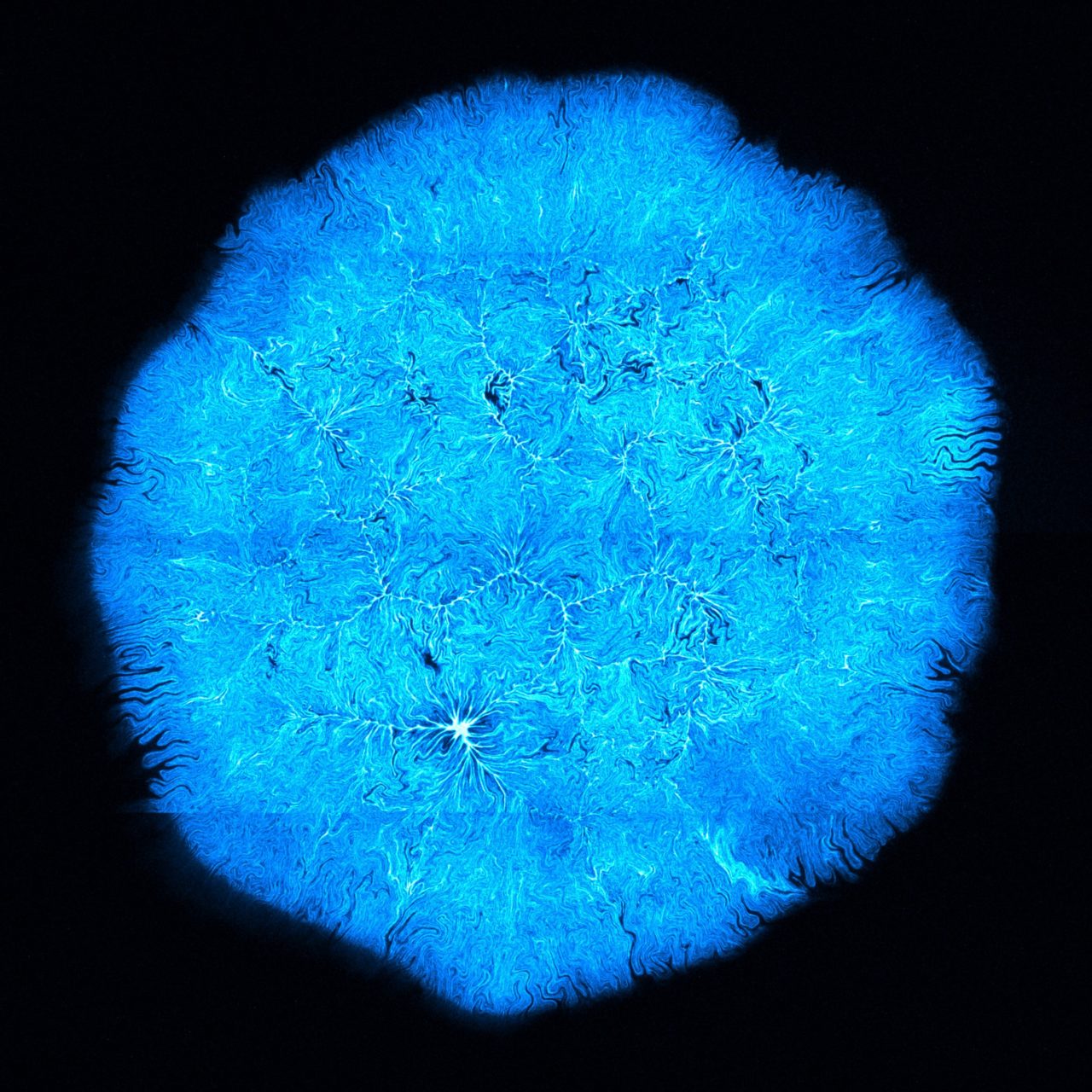
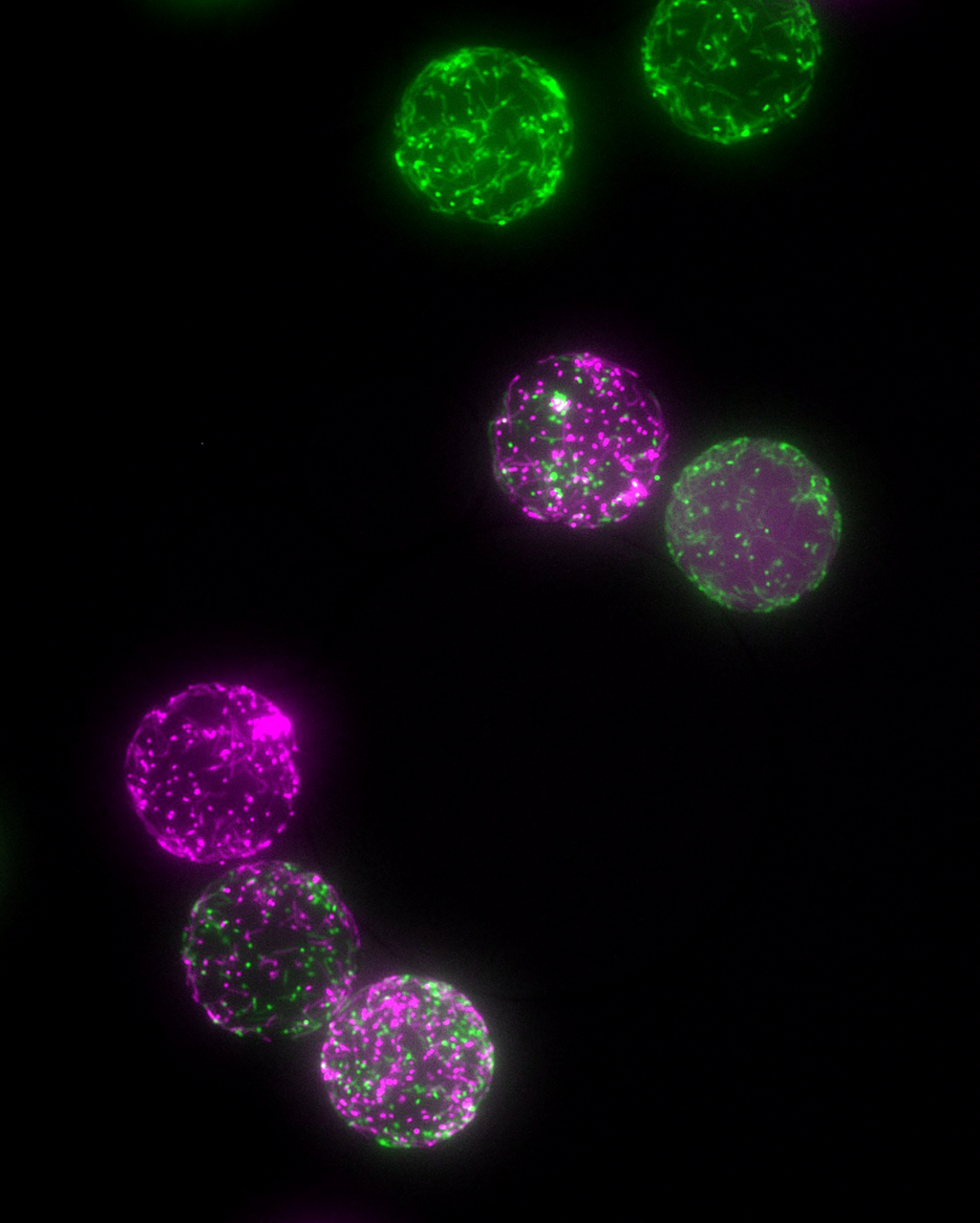
LIFE IN A BUBBLE
Author: Maxime Batsch, UNIL
WINNER SECOND PLACE JURY PRIZE
Bacteria are often bound to live and fight within micro-habitats in nature. For us, it’s nothing more than a few microscopic water bubbles, but for them, it means the whole world. Here, we seeded a few bacteria cells from two different pseudomonas species in separated pL-droplets, where we could appreciate how they will grow and interact at a micro-scale, build together multiple versions of their own worlds in parallel, and create a diversity of possible outcomes.
ORIGINS
Author: Asli Sahin, EPFL
WINNER OF THE AUDIENCE PRIZE
The ancestral lineages formed during colony expansion of the synthetic microbial community composed of two auxotrophic E. coli strains. The image was generated using CROMICS, an individual-based modeling framework. Microbial metabolism and diffusion are simulated for 120 hours after inoculation. Cells are colored based on their initial inoculated ancestor, and the initial population consists of 7850 individuals covering a circular domain of 2.5 mm diameter.


HARMONY IN DIVERSITY
Author: Yangji Choi, CHUV
Drawing from the NCCR’s distinctive palette, “Harmony in Diversity” illustrates in vibrant watercolor brushstrokes the elaborate dance of microorganisms coexisting in a marvellously complex ecosystem.
The unique shapes and varied colors of each stroke also represent the diversity of scientists with different curiosities, approaches, and viewpoints within NCCR dedicated to the study of the mysterious world of microbiomes.
This artwork reflects the harmony of the microbiome and the scientific community, highlighting the beauty of diversity.
MINIMAL MICROBIOTA
Author: Giorgia Greter, ETH Zurich
This is an image of bacteria in a mouse large intestine. The mouse was colonized with the Easily Accessible Microbiota (EAM), which is a minimal microbiota composed of three species. Bacteroides thetaiotaomicron is pictured in pink, Eubacterium rectaleis pictured in blue, and Escherichia coli is pictured in orange. This image displays how bacteria are heterogeneously distributed in the large intestine, with large spaces in the image containing very few bacteria and others being densely colonized. Bacteria are also clustered together on a small scale with other members of the same species, indicating the formation of microcolonies in the gut. Microcolonies of clustered bacteria are disrupted by gut contractions, and the gut content is mixed together.
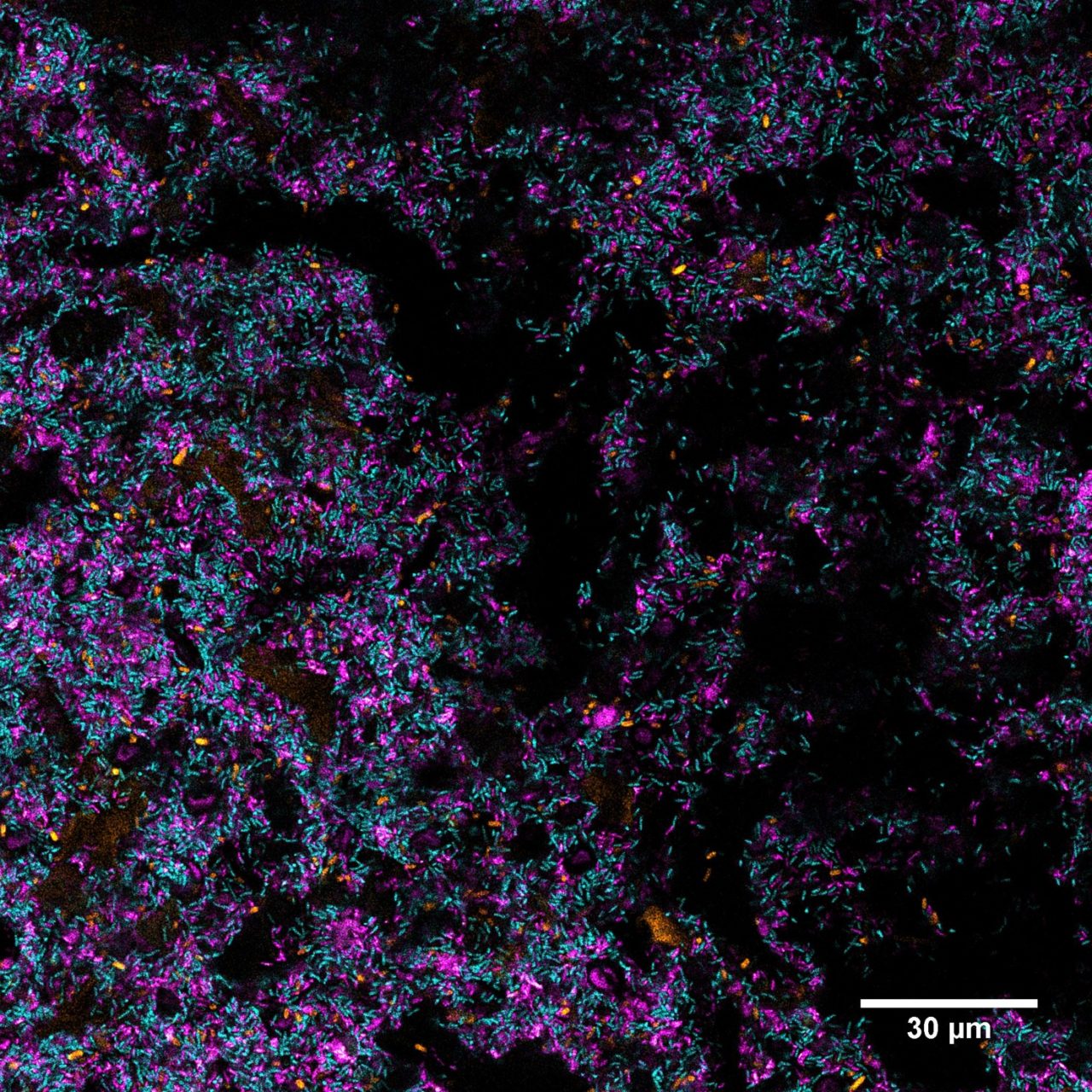
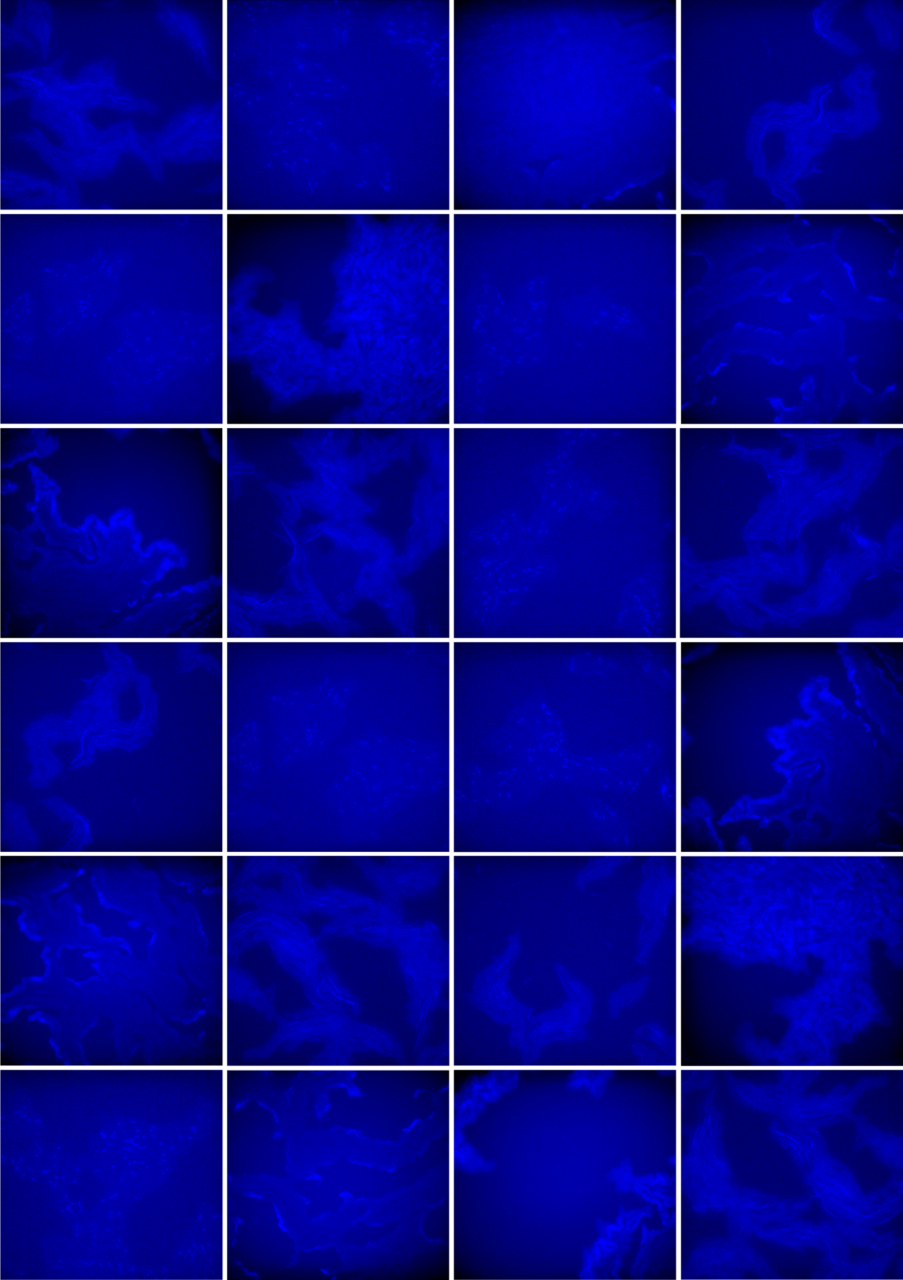
SHINING IN THE SPOTLIGHT
Author: Bouke Bentvelsen, UNIL
In the world of the unseen, a remarkable process unfolds: bacterial autofluorescence.
When exposed to high quantities of light, certain bacteria emit their own unique glow, revealing their distinct identities through colours and patterns. Each blue pattern corresponds to a specific bacterial species.
We use this phenomenon as a tool for identification. By observing the fluorescent light emitted by bacteria under a microscope, we can improve the determination of the types of bacteria present in a sample. This technique is particularly useful in studying complex microbial communities, such as those in soil. Thus, these lights and colours aid our understanding of the microscopic world.
SMILE!
Author: Tania Miguel Trabajo, UNIL
What do you see?
Pareidolia is a human tendency to see meaning where there is none.
In this picture, what you can actually see is an agarose patch covered in millions of bacterial cells. These cells have been engineered to fluoresce under blue light. After growing for a few hours, they become so numerous and bright that we can see them under very low magnifications.
What I do see, is microbes smiling at me 🙂
Pseudomonas putida F1 on 1% agarose with minimal media and carbon source, ZEISS LSM 900 confocal microscope, 50x magnification.

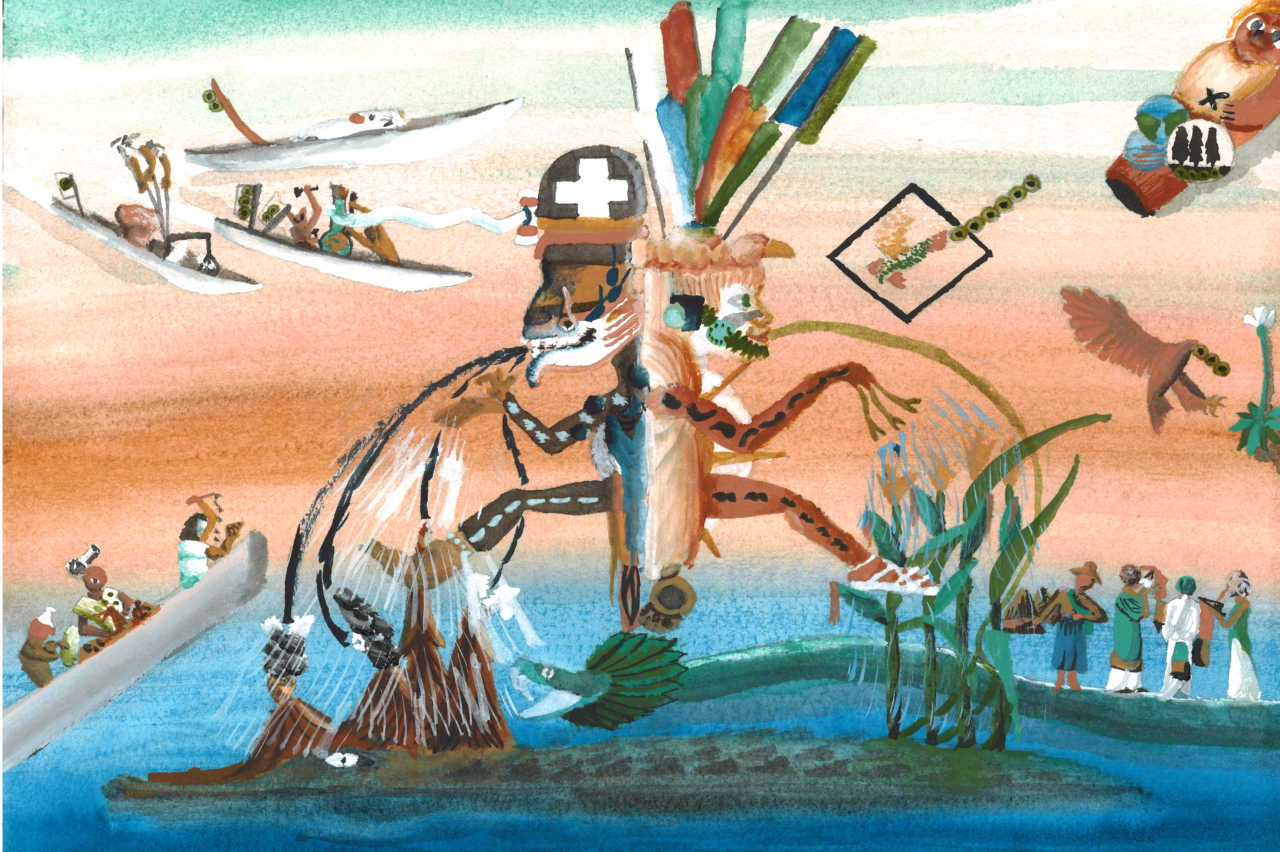
DUALITY
Author: Eugenio Pérez Molphe Montoya
The Duality is a Mesoamerican foundational concept: the cosmos and everything in it is a fractal system of identities made of two identities opposite and complementary. The identities kill and give birth to each other, they always change, no one disappear forever, because they need their opposite to exist.
There are some plants on the back of a crocodile that are influenced in contrasting ways by the “Microbiome-Duality” and feeds it at the same time. Quetzalcoatl is there too carrying some figures, some are “knitting” books, other is showing them houses. A boat is carrying a figure observing something white and green, other sculpting corn and other crops and other writing. Surrounding the central figure are a series of scenes that represent each Work Package of the Consortium, you just must count the green balls in each scene to know which Work Package is represented.
SEA OF MICROBES
Author: Bruna Fornasari, UNIL
At the beginning, all you want to do is encapsulate some bacteria in beads so they can grow inside; and in the end, your bacteria have indeed grown but not a single one is in a bead. Instead they have formed a nice, wavy biofilm. Makes you think of vacations.
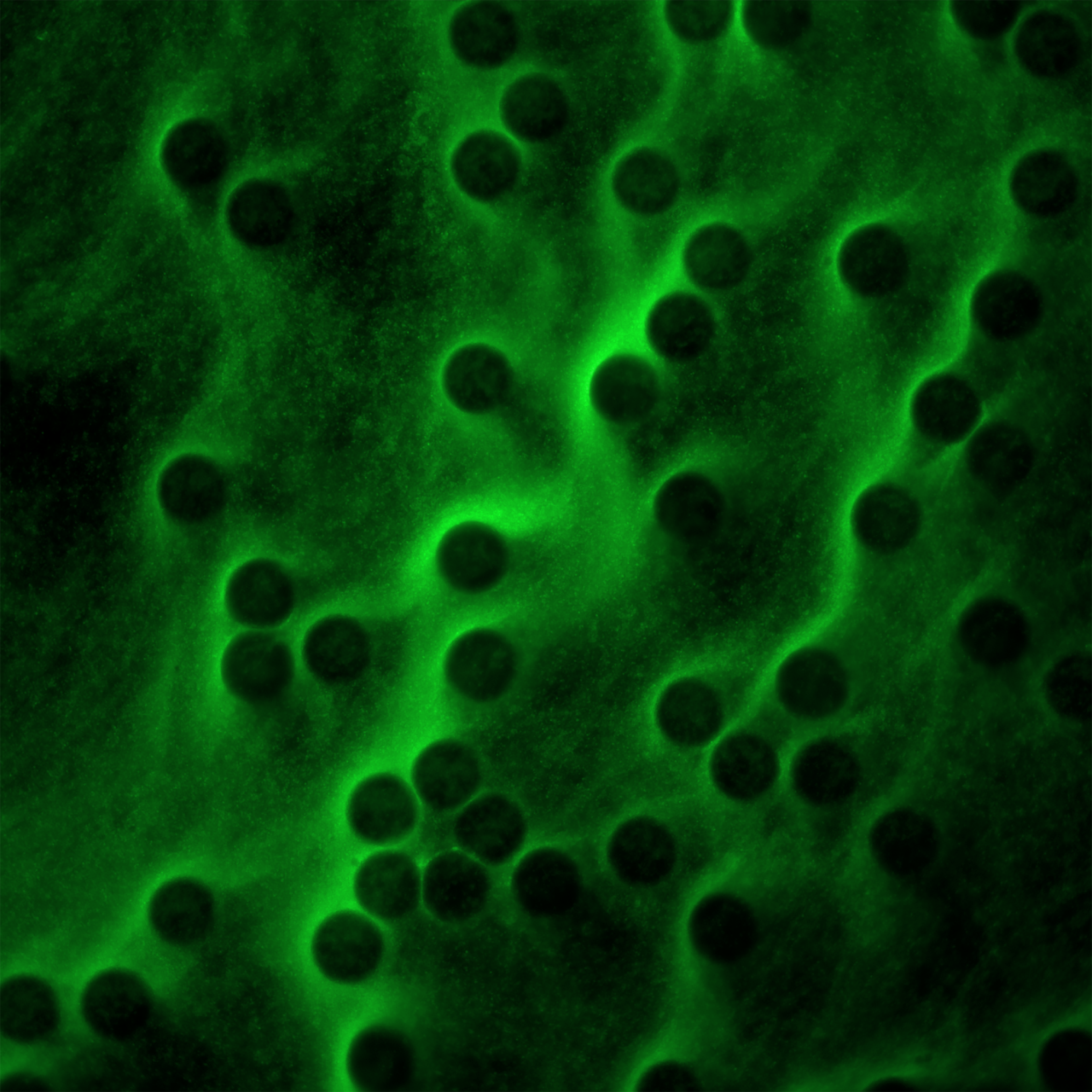
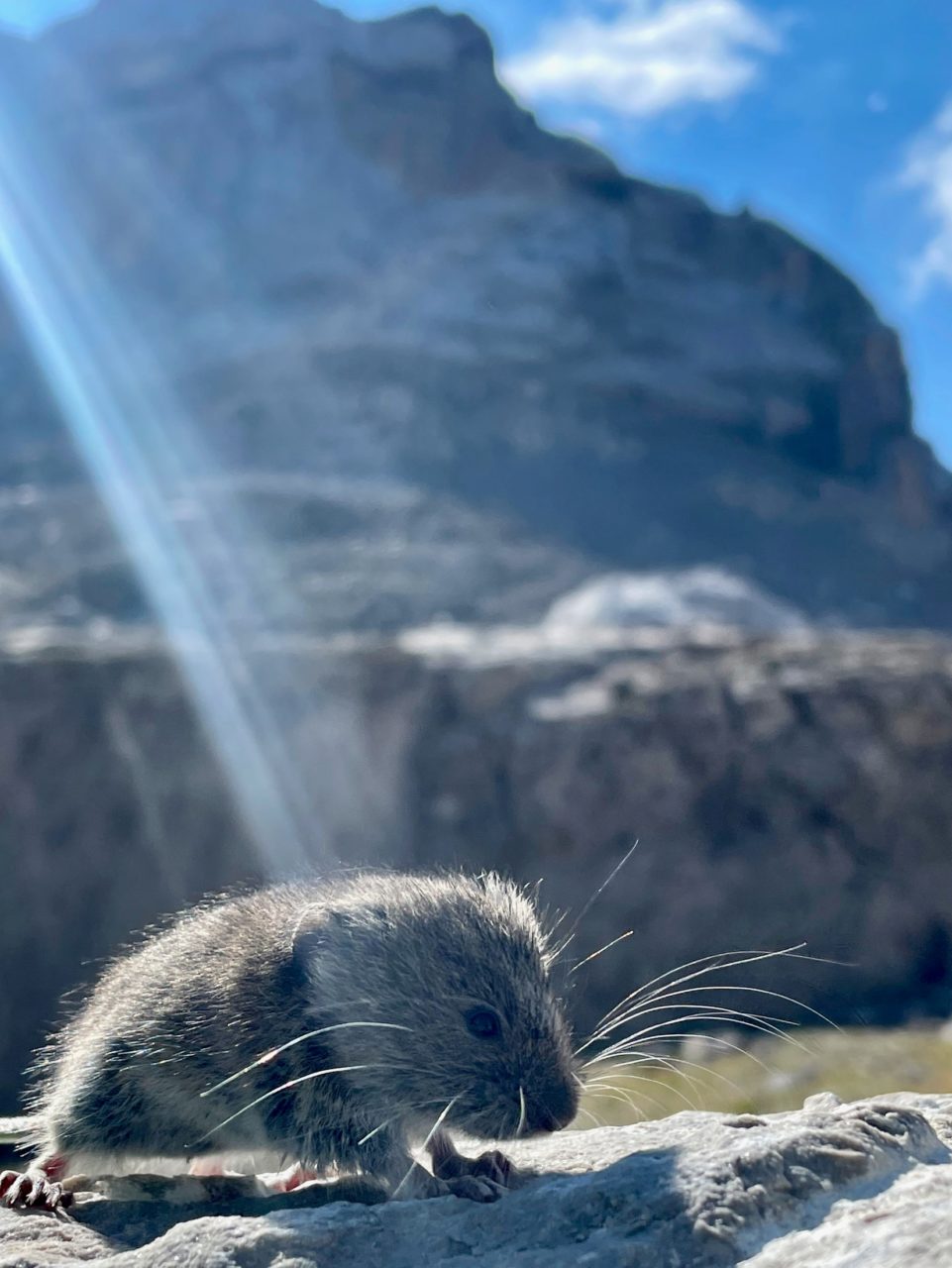
EXPLORING THE UNCHARTED GUT MICROBIOTA OF THE EUROPEAN SNOW VOLE
Author: Florent Mazel/Lucie Mallard
The European snow vole (Chionomys nivalis) is a small herbivorous rodent thriving in extreme conditions at high altitude in the Alps (up to 4700 masl). The project aims to explore how the gut microbiota functions varies across populations living at different altitudes and might participate to host adaptation to this harsh environment.
This photo was taken by Lucie Mallard during a field trip led by Florent Mazel (both at UNIL) in Les Diablerets in summer 2022 (altitude : 2400 masl).
INTO THE UNKNOWN
Author: Jordan Vacheron, UNIL
As it undergoes a peculiar cell division, stretching into a question mark-like shape, vibrant green foci emerged corresponding to ongoing-produced viral particles. Why this bacterium and not another one? Why this curious shape? What will be the fate of this elongated bacterium?
This picture symbolizes our journey “into the Unknown”, a portal to the uncharted territory of viral particles, where countless questions await answers.
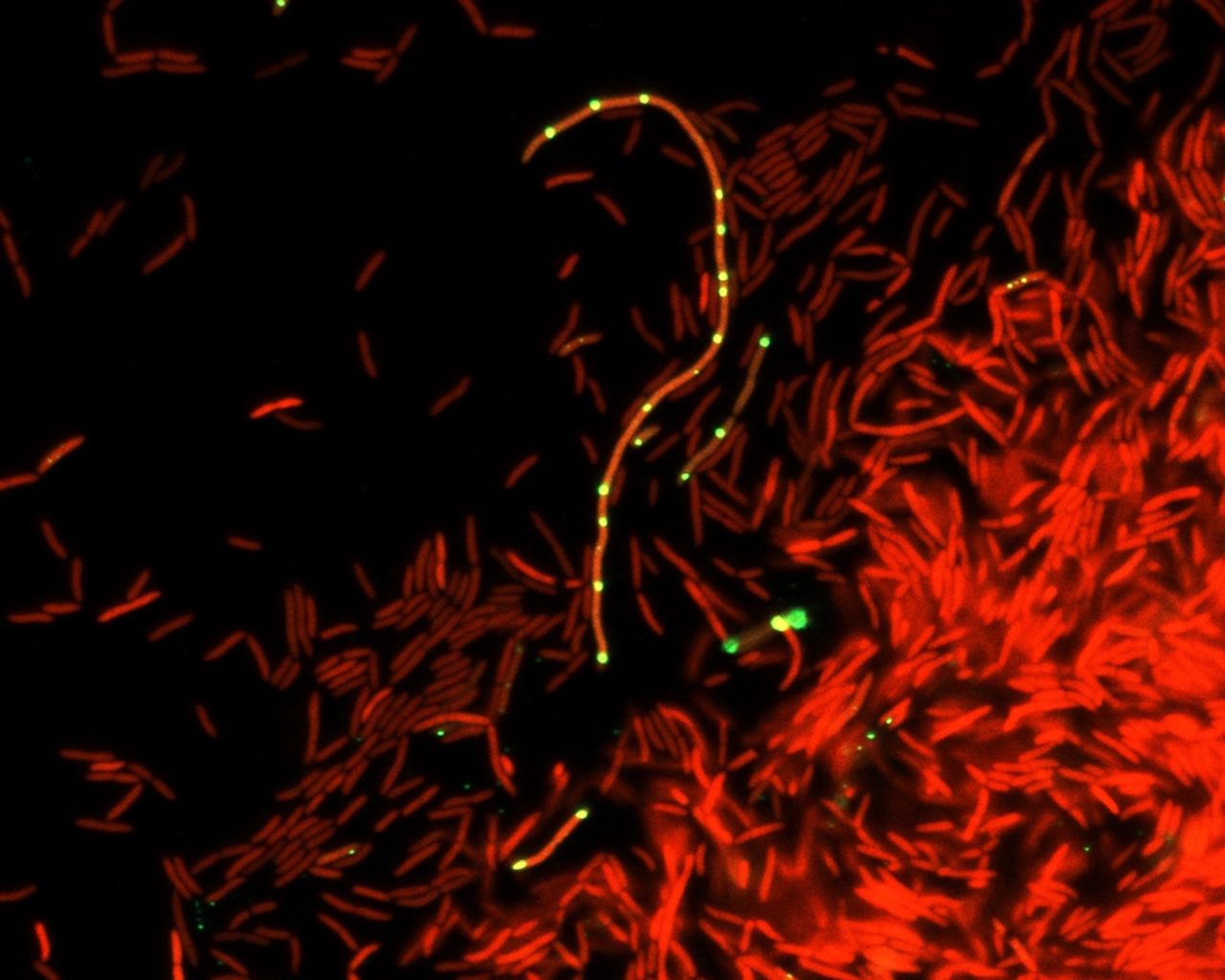
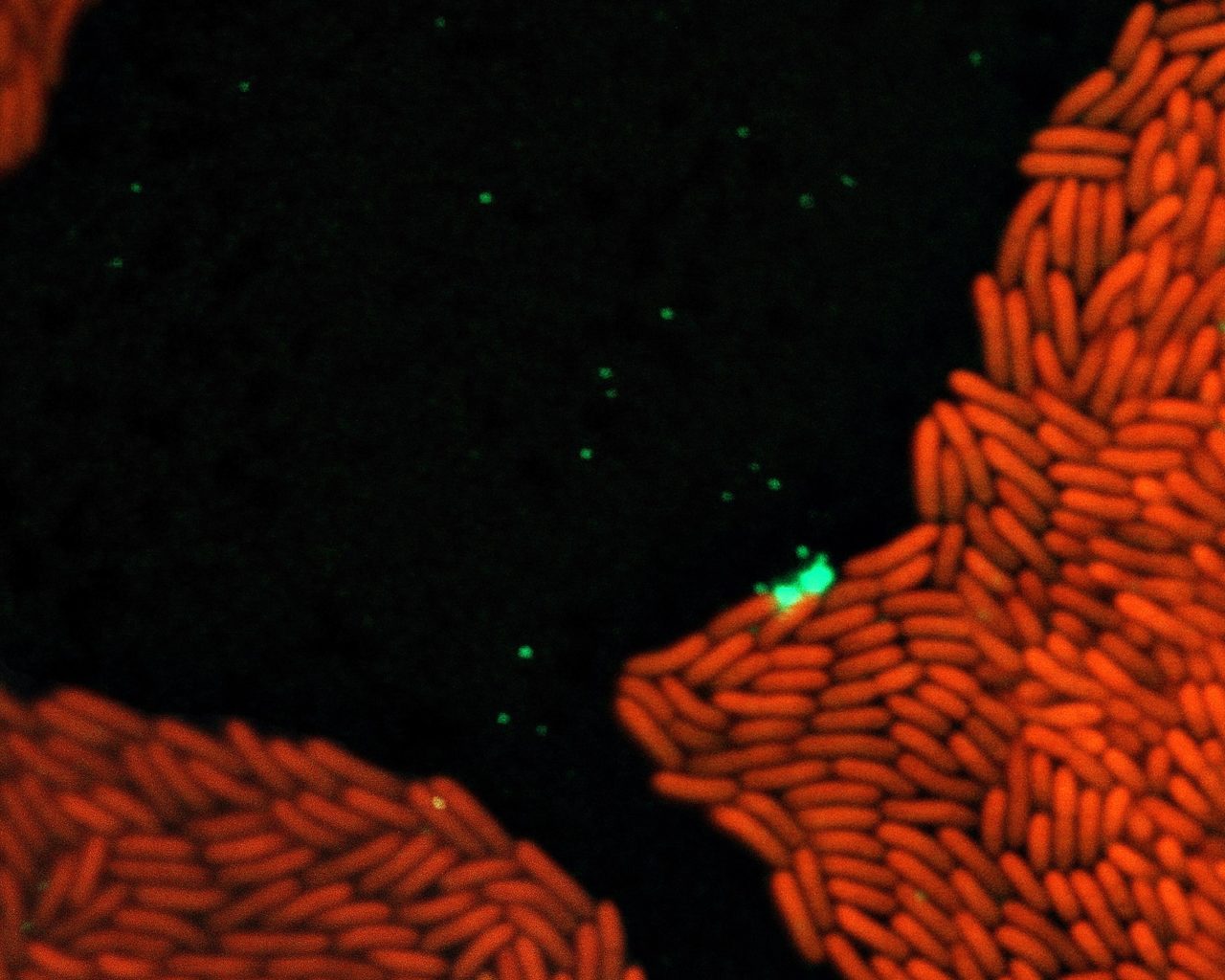
UNUS PRO OMNIBUS, OMNES PRO UNO
Author: Jordan Vacheron, UNIL
French | « Un pour tous et tous pour un »
German | « Einer für Alle, Alle für Einen »
Italian | « Uno per tuti, tuti per uno »
Romansh | « In per tuts, tuts per in »
English | « One for all, and all for one »
In the microscopic battleground, a lone bacterium, producing phage tail-like particles that defend its fellow microbe comrades. Amidst this tiny drama, the viral particles, marked in green, are released following explosive cell-lysis, their mission clear: to protect and prevent the potential invasion by kin bacteria. This mesmerizing microscopy picture echoes one of the major Switzerland’s myths, akin to Arnold Winkelried’s sacrifice at the Battle of Sempach, enabling Confederates to break through enemy lines and secure victory.